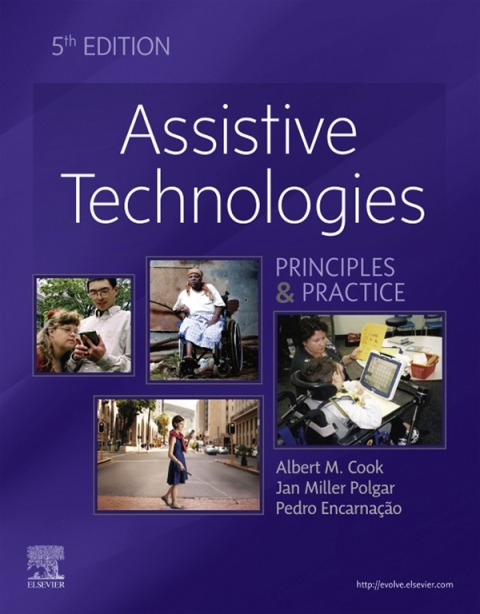Description
Efnisyfirlit
- Cover image
- Title page
- Table of Contents
- Copyright
- Dedication
- Preface
- Acknowledgments
- 1. Principles of Assistive Technology: Introducing the Human Activity Assistive Technology Model
- Introduction
- Constructs of Disability in Key Documents
- Definitions of Assistive Technology
- Principles of Assistive Technology Service Delivery
- The Human Activity Assistive Technology Model
- Application of the Human Activity Assistive Technology Model
- Summary
- 2. Technologies That Assist People Who Have Disabilities
- The Changing World of Assistive Technologies and Its Impact on Persons with Disabilities
- Technology Options for Meeting the Needs of Individuals Who Have Disabilities
- A Functional Framework for Assistive Technologies
- Summary
- 3. Activity, Human, and Context
- Introduction
- Activity
- The Human User
- Context
- Reassembling the HAAT Model
- Summary
- 4. Global Perspective on Assistive Technology
- Context: The worldwide political framework
- Human: Prevalence of disability
- Activity: Early childhood, education, employment, and retirement
- Assistive Technology: Access to Assistive Technology
- Summary
- 5. Ethical Issues in Assistive Technology
- Introduction
- The Ethical Context
- Autonomy
- Fidelity
- Beneficence
- Nonmaleficence
- Justice
- Application of Ethical Concepts in Assistive Technology
- Stigma
- Informed Consent
- Self-Determination
- Privacy
- Equitable Assistive Technology Distribution of Assistive Technology: Who Gets What?
- Summary
- 6. Delivering Assistive Technology Services to the Client
- Introduction
- Principles of Assistive Technology Delivery
- Overview of Service Delivery in Assistive Technology
- A Final Word About Funding
- Summary
- 7. User Input
- Activity: Enabling Participation
- Assistive Technology: Connecting the User to the Technology
- Direct Selection
- Selection Formats for Scanning
- Selection Techniques for Scanning
- Rate Enhancement
- Digital Recording
- Speech Synthesis
- Text-to-Speech Programs
- Audio Considerations
- Context
- Assessment
- Functional Movement Evaluation
- Outcomes
- Summary
- 8. Control Interfaces for Assistive Technologies
- Activity: Enabling Participation
- Human Skills for Control: Characteristics of Controlled Movements
- Assistive Technology: Characteristics of Control Interfaces
- Control Interfaces for Direct Selection
- Control Interfaces for Indirect Selection
- Context
- Assessment
- Outcomes: Is It Working? Evaluating the Effectiveness of a Control Interface
- Summary
- 9. Input Accessibility for Mainstream Information and Communication Technologies
- Activity: Accessing the Information Highway
- Human: Challenges in Using Mainstream ICTs for Persons With Disabilities
- Assistive Technology: Input Accessibility for Mainstream ICTs
- Cross-Platform Accessibility
- Computer Access
- Access to Phones and Tablets
- Mounting
- Context
- Assessment
- Outcomes
- Summary
- 10. Enabling Function and Participation With Seating Technologies
- Introduction
- Activity
- Human
- Context
- Assistive Technologies for Seating and Positioning
- Seating Technologies
- Seating Assessment
- Intervention
- Outcome Evaluation
- Summary
- 11. Technologies That Enable Mobility
- Activity Component
- Human Component
- Context Components
- Assistive Technology
- Smart Wheelchairs
- Wheelchair Standards
- Assessment for Wheeled Mobility
- Implementation and Training for Manual and Powered Mobility
- Outcome Evaluation
- Summary
- 12. Technologies That Aid Transportation
- Activity
- Human
- Context
- Assistive Technology
- Safe Transportation of Individuals in Wheelchairs
- Technologies for Transportation and Driving
- Assessment
- Outcome Evaluation
- Summary
- 13. Enabling Manipulation With Low-Technology Assistive Devices
- Activity Component
- Human Component
- Context Component
- Low-Technology Aids for Manipulation
- Summary
- 14. Electronic Aids to Daily Living
- Activity Component
- Human Component
- Context Component
- Assistive Technology Component
- Assessment for Use of EADLs
- Outcomes of EADL Use
- Summary
- 15. Robotic Assistive Technologies That Aid Manipulation
- Activity Component
- Human Component
- Context Component
- Robotic Aids to Manipulation
- Assessment for Robotic Augmentative Manipulation
- Outcomes
- Summary
- 16. Sensory Aids for Persons With Visual Impairments
- Activity Component
- Human Component
- Assistive Technologies for Vision
- Auditory Substitution
- Optical Aids
- Nonoptical Aids
- Electronic Aids
- Limitations of Printed Braille
- Refreshable Braille Displays
- Recorded Audio Material
- Canes
- Alternative Mobility Devices
- Context Component
- Assessment
- Orientation and Mobility Assessment
- Outcomes
- Summary
- 17. Assistive Technologies for Cognitive Augmentation
- Activity Component
- Human Component
- Disorders that may Benefit from Cognitive Assistive Technologies
- Cognitive Skills Related to Specific Disorders
- Assistive Technologies that Address Cognitive Needs
- Cognitive Assistive Technologies
- Disadvantages of Multi-Purpose Devices
- Mainstream Technology Use by Persons with TBI and Stroke
- Context Component
- Assessment
- Outcomes
- Summary
- 18. Augmentative and Alternative Communication Systems
- Activity Component
- Human Component
- Context Component
- Assistive Technologies for Alternative and Augmentative Communication
- AAC System Outputs
- Access to Mainstream Technologies
- Internet Access
- Mobile Phones
- Special considerations of AAC systems for specific disabilities
- Mobile Technologies as Speech-Generating Devices
- Physical Skill Development
- Augmentative and Alternative Communication Evaluation and Assessment
- Outcomes
- Summary
- Glossary
- Index






Reviews
There are no reviews yet.